Management of Organizational Performance
VerifiedAdded on 2023/04/23
|8
|2022
|75
AI Summary
The report analyzes the initiatives taken by Qantas Airways to improve employee performance, engagement and organizational culture. The report highlights the importance of effective HRM practices for organizational success and provides recommendations for further improvement.
Contribute Materials
Your contribution can guide someone’s learning journey. Share your
documents today.
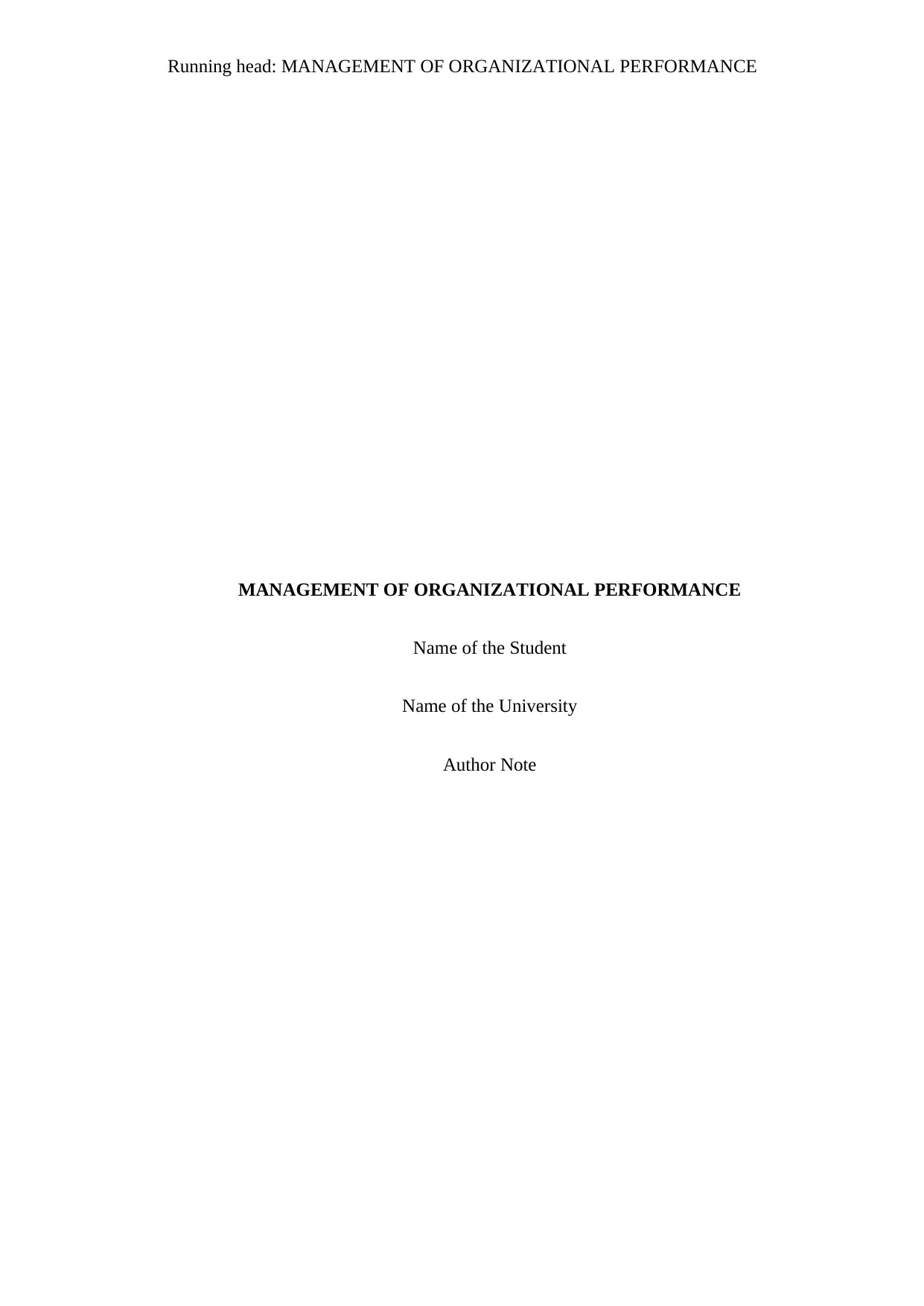
Running head: MANAGEMENT OF ORGANIZATIONAL PERFORMANCE
MANAGEMENT OF ORGANIZATIONAL PERFORMANCE
Name of the Student
Name of the University
Author Note
MANAGEMENT OF ORGANIZATIONAL PERFORMANCE
Name of the Student
Name of the University
Author Note
Secure Best Marks with AI Grader
Need help grading? Try our AI Grader for instant feedback on your assignments.
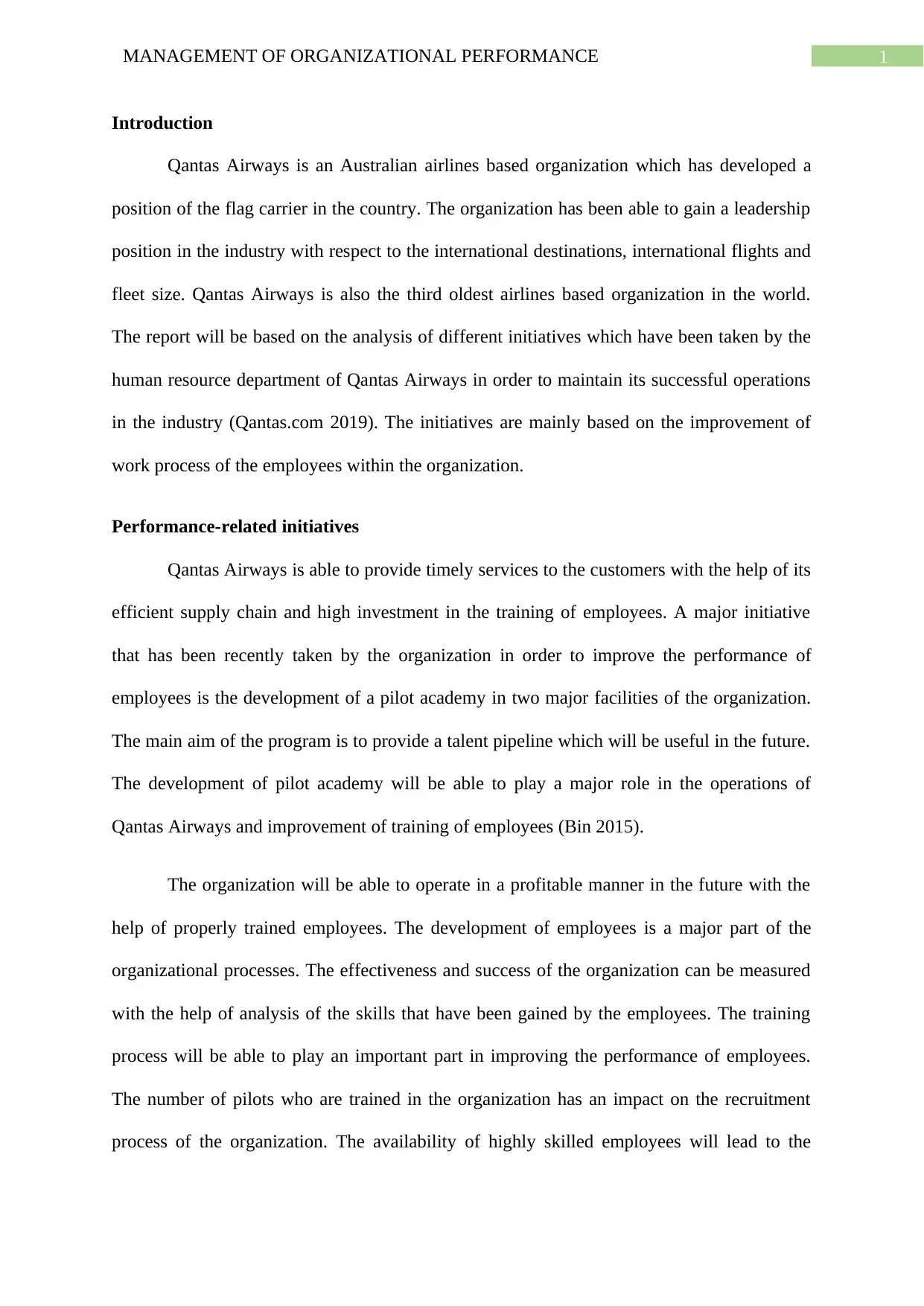
1MANAGEMENT OF ORGANIZATIONAL PERFORMANCE
Introduction
Qantas Airways is an Australian airlines based organization which has developed a
position of the flag carrier in the country. The organization has been able to gain a leadership
position in the industry with respect to the international destinations, international flights and
fleet size. Qantas Airways is also the third oldest airlines based organization in the world.
The report will be based on the analysis of different initiatives which have been taken by the
human resource department of Qantas Airways in order to maintain its successful operations
in the industry (Qantas.com 2019). The initiatives are mainly based on the improvement of
work process of the employees within the organization.
Performance-related initiatives
Qantas Airways is able to provide timely services to the customers with the help of its
efficient supply chain and high investment in the training of employees. A major initiative
that has been recently taken by the organization in order to improve the performance of
employees is the development of a pilot academy in two major facilities of the organization.
The main aim of the program is to provide a talent pipeline which will be useful in the future.
The development of pilot academy will be able to play a major role in the operations of
Qantas Airways and improvement of training of employees (Bin 2015).
The organization will be able to operate in a profitable manner in the future with the
help of properly trained employees. The development of employees is a major part of the
organizational processes. The effectiveness and success of the organization can be measured
with the help of analysis of the skills that have been gained by the employees. The training
process will be able to play an important part in improving the performance of employees.
The number of pilots who are trained in the organization has an impact on the recruitment
process of the organization. The availability of highly skilled employees will lead to the
Introduction
Qantas Airways is an Australian airlines based organization which has developed a
position of the flag carrier in the country. The organization has been able to gain a leadership
position in the industry with respect to the international destinations, international flights and
fleet size. Qantas Airways is also the third oldest airlines based organization in the world.
The report will be based on the analysis of different initiatives which have been taken by the
human resource department of Qantas Airways in order to maintain its successful operations
in the industry (Qantas.com 2019). The initiatives are mainly based on the improvement of
work process of the employees within the organization.
Performance-related initiatives
Qantas Airways is able to provide timely services to the customers with the help of its
efficient supply chain and high investment in the training of employees. A major initiative
that has been recently taken by the organization in order to improve the performance of
employees is the development of a pilot academy in two major facilities of the organization.
The main aim of the program is to provide a talent pipeline which will be useful in the future.
The development of pilot academy will be able to play a major role in the operations of
Qantas Airways and improvement of training of employees (Bin 2015).
The organization will be able to operate in a profitable manner in the future with the
help of properly trained employees. The development of employees is a major part of the
organizational processes. The effectiveness and success of the organization can be measured
with the help of analysis of the skills that have been gained by the employees. The training
process will be able to play an important part in improving the performance of employees.
The number of pilots who are trained in the organization has an impact on the recruitment
process of the organization. The availability of highly skilled employees will lead to the
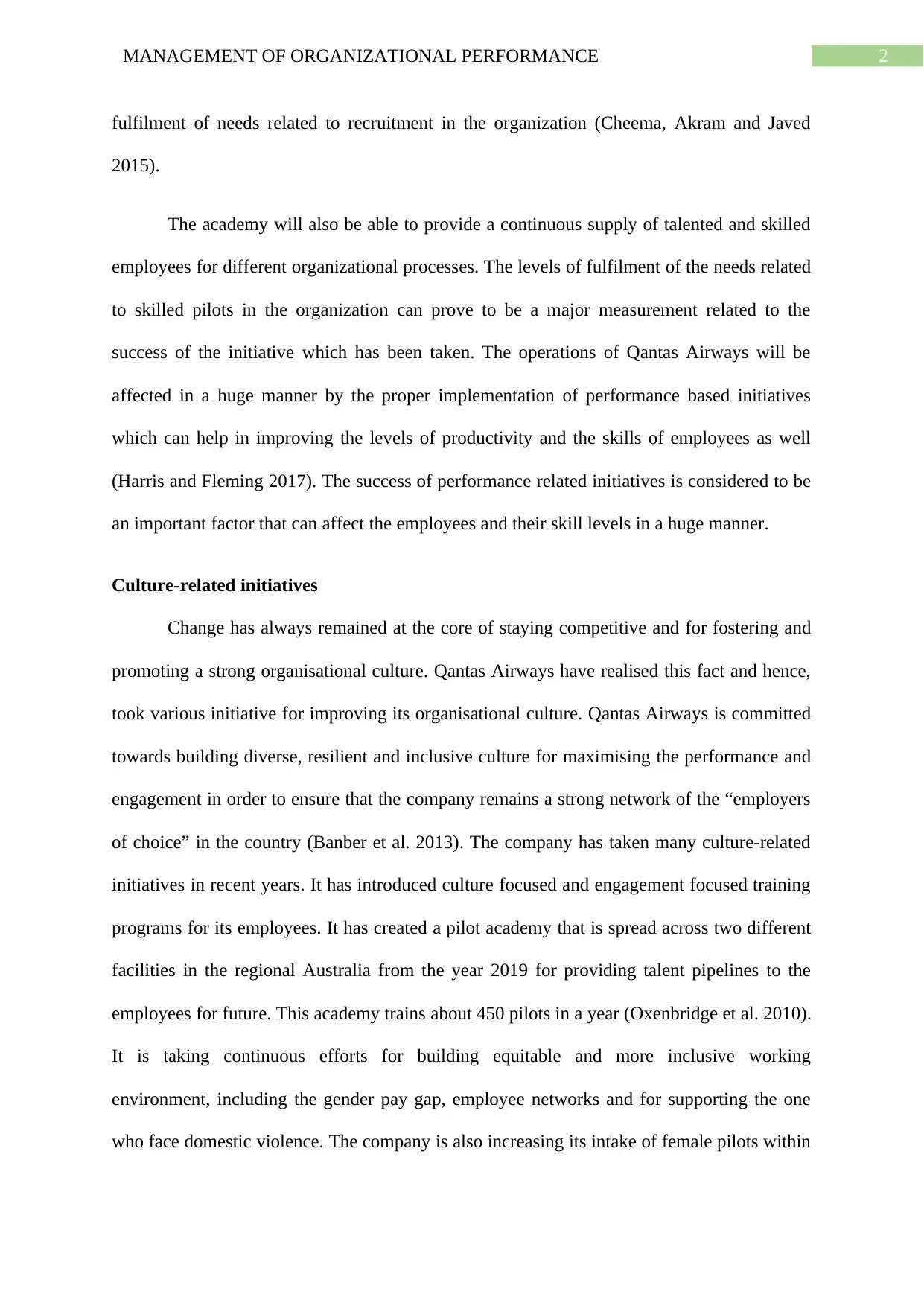
2MANAGEMENT OF ORGANIZATIONAL PERFORMANCE
fulfilment of needs related to recruitment in the organization (Cheema, Akram and Javed
2015).
The academy will also be able to provide a continuous supply of talented and skilled
employees for different organizational processes. The levels of fulfilment of the needs related
to skilled pilots in the organization can prove to be a major measurement related to the
success of the initiative which has been taken. The operations of Qantas Airways will be
affected in a huge manner by the proper implementation of performance based initiatives
which can help in improving the levels of productivity and the skills of employees as well
(Harris and Fleming 2017). The success of performance related initiatives is considered to be
an important factor that can affect the employees and their skill levels in a huge manner.
Culture-related initiatives
Change has always remained at the core of staying competitive and for fostering and
promoting a strong organisational culture. Qantas Airways have realised this fact and hence,
took various initiative for improving its organisational culture. Qantas Airways is committed
towards building diverse, resilient and inclusive culture for maximising the performance and
engagement in order to ensure that the company remains a strong network of the “employers
of choice” in the country (Banber et al. 2013). The company has taken many culture-related
initiatives in recent years. It has introduced culture focused and engagement focused training
programs for its employees. It has created a pilot academy that is spread across two different
facilities in the regional Australia from the year 2019 for providing talent pipelines to the
employees for future. This academy trains about 450 pilots in a year (Oxenbridge et al. 2010).
It is taking continuous efforts for building equitable and more inclusive working
environment, including the gender pay gap, employee networks and for supporting the one
who face domestic violence. The company is also increasing its intake of female pilots within
fulfilment of needs related to recruitment in the organization (Cheema, Akram and Javed
2015).
The academy will also be able to provide a continuous supply of talented and skilled
employees for different organizational processes. The levels of fulfilment of the needs related
to skilled pilots in the organization can prove to be a major measurement related to the
success of the initiative which has been taken. The operations of Qantas Airways will be
affected in a huge manner by the proper implementation of performance based initiatives
which can help in improving the levels of productivity and the skills of employees as well
(Harris and Fleming 2017). The success of performance related initiatives is considered to be
an important factor that can affect the employees and their skill levels in a huge manner.
Culture-related initiatives
Change has always remained at the core of staying competitive and for fostering and
promoting a strong organisational culture. Qantas Airways have realised this fact and hence,
took various initiative for improving its organisational culture. Qantas Airways is committed
towards building diverse, resilient and inclusive culture for maximising the performance and
engagement in order to ensure that the company remains a strong network of the “employers
of choice” in the country (Banber et al. 2013). The company has taken many culture-related
initiatives in recent years. It has introduced culture focused and engagement focused training
programs for its employees. It has created a pilot academy that is spread across two different
facilities in the regional Australia from the year 2019 for providing talent pipelines to the
employees for future. This academy trains about 450 pilots in a year (Oxenbridge et al. 2010).
It is taking continuous efforts for building equitable and more inclusive working
environment, including the gender pay gap, employee networks and for supporting the one
who face domestic violence. The company is also increasing its intake of female pilots within
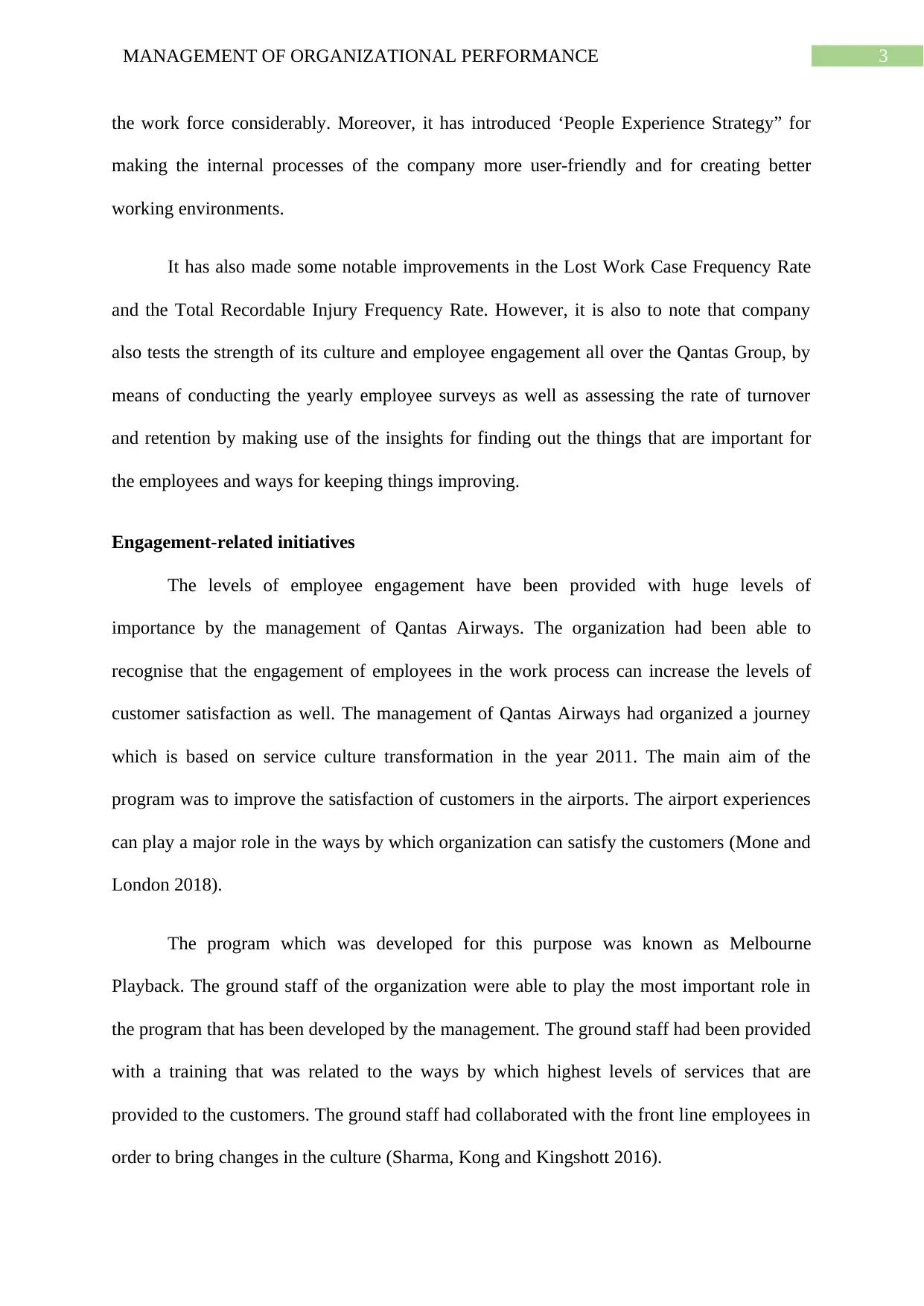
3MANAGEMENT OF ORGANIZATIONAL PERFORMANCE
the work force considerably. Moreover, it has introduced ‘People Experience Strategy” for
making the internal processes of the company more user-friendly and for creating better
working environments.
It has also made some notable improvements in the Lost Work Case Frequency Rate
and the Total Recordable Injury Frequency Rate. However, it is also to note that company
also tests the strength of its culture and employee engagement all over the Qantas Group, by
means of conducting the yearly employee surveys as well as assessing the rate of turnover
and retention by making use of the insights for finding out the things that are important for
the employees and ways for keeping things improving.
Engagement-related initiatives
The levels of employee engagement have been provided with huge levels of
importance by the management of Qantas Airways. The organization had been able to
recognise that the engagement of employees in the work process can increase the levels of
customer satisfaction as well. The management of Qantas Airways had organized a journey
which is based on service culture transformation in the year 2011. The main aim of the
program was to improve the satisfaction of customers in the airports. The airport experiences
can play a major role in the ways by which organization can satisfy the customers (Mone and
London 2018).
The program which was developed for this purpose was known as Melbourne
Playback. The ground staff of the organization were able to play the most important role in
the program that has been developed by the management. The ground staff had been provided
with a training that was related to the ways by which highest levels of services that are
provided to the customers. The ground staff had collaborated with the front line employees in
order to bring changes in the culture (Sharma, Kong and Kingshott 2016).
the work force considerably. Moreover, it has introduced ‘People Experience Strategy” for
making the internal processes of the company more user-friendly and for creating better
working environments.
It has also made some notable improvements in the Lost Work Case Frequency Rate
and the Total Recordable Injury Frequency Rate. However, it is also to note that company
also tests the strength of its culture and employee engagement all over the Qantas Group, by
means of conducting the yearly employee surveys as well as assessing the rate of turnover
and retention by making use of the insights for finding out the things that are important for
the employees and ways for keeping things improving.
Engagement-related initiatives
The levels of employee engagement have been provided with huge levels of
importance by the management of Qantas Airways. The organization had been able to
recognise that the engagement of employees in the work process can increase the levels of
customer satisfaction as well. The management of Qantas Airways had organized a journey
which is based on service culture transformation in the year 2011. The main aim of the
program was to improve the satisfaction of customers in the airports. The airport experiences
can play a major role in the ways by which organization can satisfy the customers (Mone and
London 2018).
The program which was developed for this purpose was known as Melbourne
Playback. The ground staff of the organization were able to play the most important role in
the program that has been developed by the management. The ground staff had been provided
with a training that was related to the ways by which highest levels of services that are
provided to the customers. The ground staff had collaborated with the front line employees in
order to bring changes in the culture (Sharma, Kong and Kingshott 2016).
Secure Best Marks with AI Grader
Need help grading? Try our AI Grader for instant feedback on your assignments.
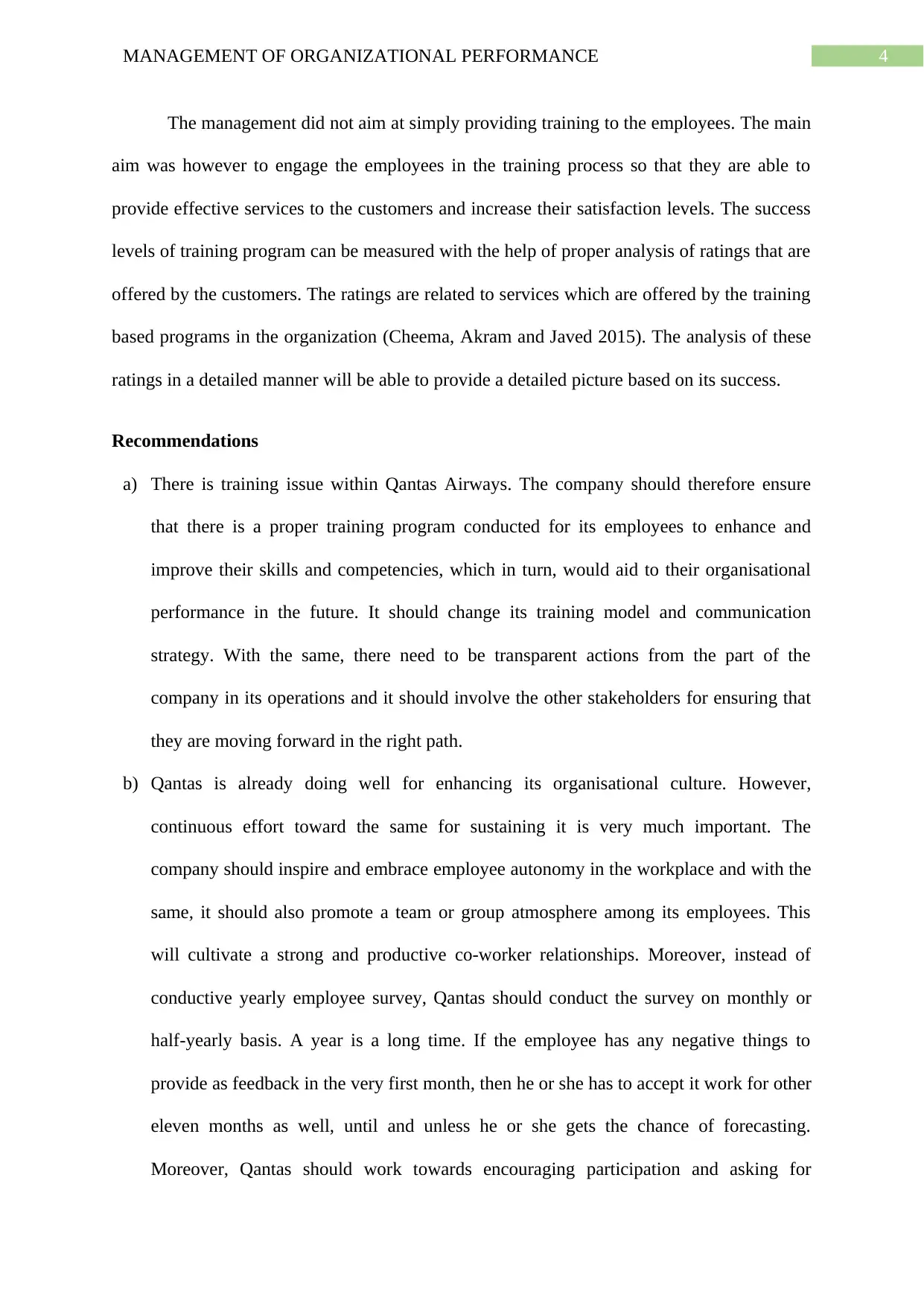
4MANAGEMENT OF ORGANIZATIONAL PERFORMANCE
The management did not aim at simply providing training to the employees. The main
aim was however to engage the employees in the training process so that they are able to
provide effective services to the customers and increase their satisfaction levels. The success
levels of training program can be measured with the help of proper analysis of ratings that are
offered by the customers. The ratings are related to services which are offered by the training
based programs in the organization (Cheema, Akram and Javed 2015). The analysis of these
ratings in a detailed manner will be able to provide a detailed picture based on its success.
Recommendations
a) There is training issue within Qantas Airways. The company should therefore ensure
that there is a proper training program conducted for its employees to enhance and
improve their skills and competencies, which in turn, would aid to their organisational
performance in the future. It should change its training model and communication
strategy. With the same, there need to be transparent actions from the part of the
company in its operations and it should involve the other stakeholders for ensuring that
they are moving forward in the right path.
b) Qantas is already doing well for enhancing its organisational culture. However,
continuous effort toward the same for sustaining it is very much important. The
company should inspire and embrace employee autonomy in the workplace and with the
same, it should also promote a team or group atmosphere among its employees. This
will cultivate a strong and productive co-worker relationships. Moreover, instead of
conductive yearly employee survey, Qantas should conduct the survey on monthly or
half-yearly basis. A year is a long time. If the employee has any negative things to
provide as feedback in the very first month, then he or she has to accept it work for other
eleven months as well, until and unless he or she gets the chance of forecasting.
Moreover, Qantas should work towards encouraging participation and asking for
The management did not aim at simply providing training to the employees. The main
aim was however to engage the employees in the training process so that they are able to
provide effective services to the customers and increase their satisfaction levels. The success
levels of training program can be measured with the help of proper analysis of ratings that are
offered by the customers. The ratings are related to services which are offered by the training
based programs in the organization (Cheema, Akram and Javed 2015). The analysis of these
ratings in a detailed manner will be able to provide a detailed picture based on its success.
Recommendations
a) There is training issue within Qantas Airways. The company should therefore ensure
that there is a proper training program conducted for its employees to enhance and
improve their skills and competencies, which in turn, would aid to their organisational
performance in the future. It should change its training model and communication
strategy. With the same, there need to be transparent actions from the part of the
company in its operations and it should involve the other stakeholders for ensuring that
they are moving forward in the right path.
b) Qantas is already doing well for enhancing its organisational culture. However,
continuous effort toward the same for sustaining it is very much important. The
company should inspire and embrace employee autonomy in the workplace and with the
same, it should also promote a team or group atmosphere among its employees. This
will cultivate a strong and productive co-worker relationships. Moreover, instead of
conductive yearly employee survey, Qantas should conduct the survey on monthly or
half-yearly basis. A year is a long time. If the employee has any negative things to
provide as feedback in the very first month, then he or she has to accept it work for other
eleven months as well, until and unless he or she gets the chance of forecasting.
Moreover, Qantas should work towards encouraging participation and asking for
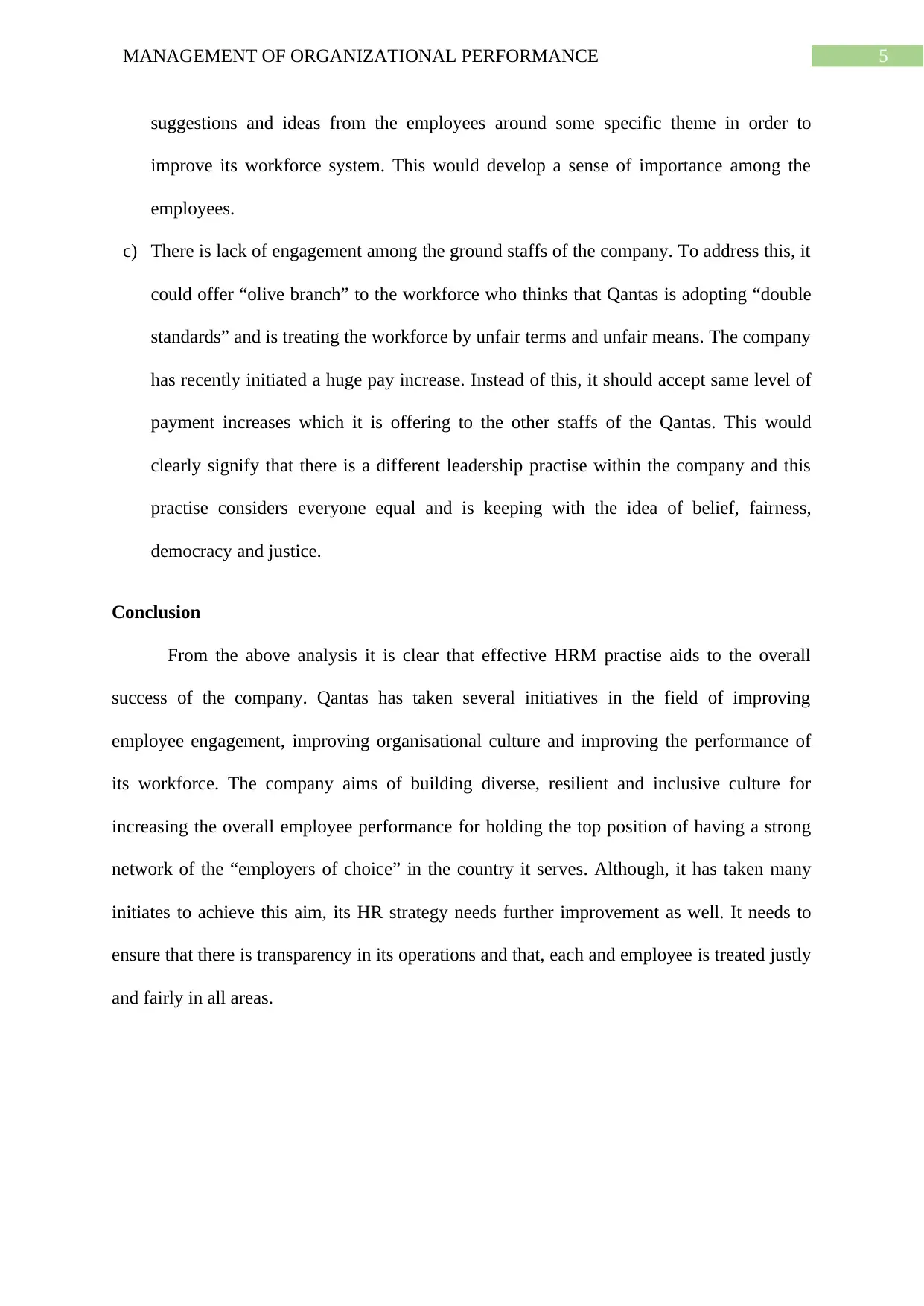
5MANAGEMENT OF ORGANIZATIONAL PERFORMANCE
suggestions and ideas from the employees around some specific theme in order to
improve its workforce system. This would develop a sense of importance among the
employees.
c) There is lack of engagement among the ground staffs of the company. To address this, it
could offer “olive branch” to the workforce who thinks that Qantas is adopting “double
standards” and is treating the workforce by unfair terms and unfair means. The company
has recently initiated a huge pay increase. Instead of this, it should accept same level of
payment increases which it is offering to the other staffs of the Qantas. This would
clearly signify that there is a different leadership practise within the company and this
practise considers everyone equal and is keeping with the idea of belief, fairness,
democracy and justice.
Conclusion
From the above analysis it is clear that effective HRM practise aids to the overall
success of the company. Qantas has taken several initiatives in the field of improving
employee engagement, improving organisational culture and improving the performance of
its workforce. The company aims of building diverse, resilient and inclusive culture for
increasing the overall employee performance for holding the top position of having a strong
network of the “employers of choice” in the country it serves. Although, it has taken many
initiates to achieve this aim, its HR strategy needs further improvement as well. It needs to
ensure that there is transparency in its operations and that, each and employee is treated justly
and fairly in all areas.
suggestions and ideas from the employees around some specific theme in order to
improve its workforce system. This would develop a sense of importance among the
employees.
c) There is lack of engagement among the ground staffs of the company. To address this, it
could offer “olive branch” to the workforce who thinks that Qantas is adopting “double
standards” and is treating the workforce by unfair terms and unfair means. The company
has recently initiated a huge pay increase. Instead of this, it should accept same level of
payment increases which it is offering to the other staffs of the Qantas. This would
clearly signify that there is a different leadership practise within the company and this
practise considers everyone equal and is keeping with the idea of belief, fairness,
democracy and justice.
Conclusion
From the above analysis it is clear that effective HRM practise aids to the overall
success of the company. Qantas has taken several initiatives in the field of improving
employee engagement, improving organisational culture and improving the performance of
its workforce. The company aims of building diverse, resilient and inclusive culture for
increasing the overall employee performance for holding the top position of having a strong
network of the “employers of choice” in the country it serves. Although, it has taken many
initiates to achieve this aim, its HR strategy needs further improvement as well. It needs to
ensure that there is transparency in its operations and that, each and employee is treated justly
and fairly in all areas.
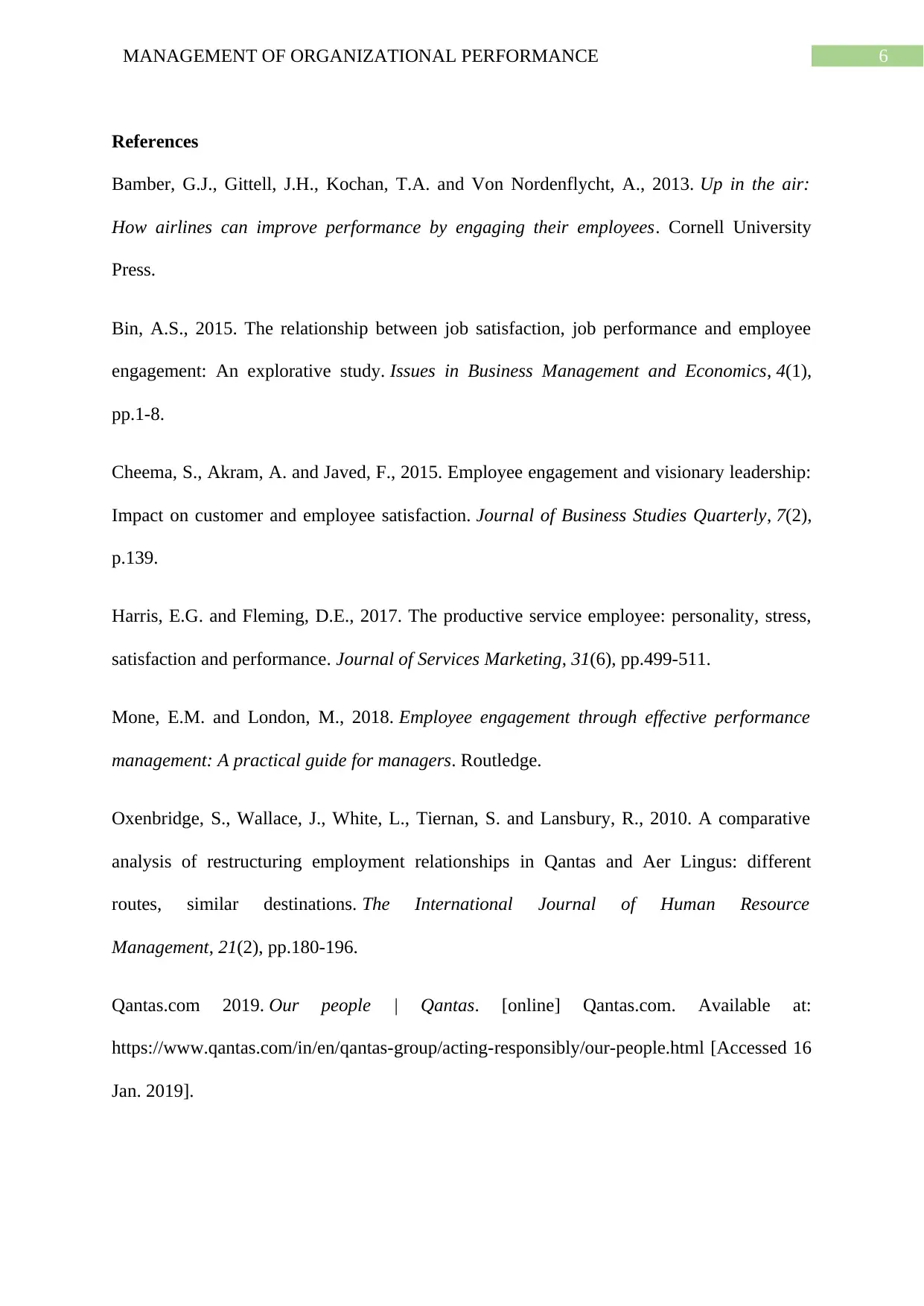
6MANAGEMENT OF ORGANIZATIONAL PERFORMANCE
References
Bamber, G.J., Gittell, J.H., Kochan, T.A. and Von Nordenflycht, A., 2013. Up in the air:
How airlines can improve performance by engaging their employees. Cornell University
Press.
Bin, A.S., 2015. The relationship between job satisfaction, job performance and employee
engagement: An explorative study. Issues in Business Management and Economics, 4(1),
pp.1-8.
Cheema, S., Akram, A. and Javed, F., 2015. Employee engagement and visionary leadership:
Impact on customer and employee satisfaction. Journal of Business Studies Quarterly, 7(2),
p.139.
Harris, E.G. and Fleming, D.E., 2017. The productive service employee: personality, stress,
satisfaction and performance. Journal of Services Marketing, 31(6), pp.499-511.
Mone, E.M. and London, M., 2018. Employee engagement through effective performance
management: A practical guide for managers. Routledge.
Oxenbridge, S., Wallace, J., White, L., Tiernan, S. and Lansbury, R., 2010. A comparative
analysis of restructuring employment relationships in Qantas and Aer Lingus: different
routes, similar destinations. The International Journal of Human Resource
Management, 21(2), pp.180-196.
Qantas.com 2019. Our people | Qantas. [online] Qantas.com. Available at:
https://www.qantas.com/in/en/qantas-group/acting-responsibly/our-people.html [Accessed 16
Jan. 2019].
References
Bamber, G.J., Gittell, J.H., Kochan, T.A. and Von Nordenflycht, A., 2013. Up in the air:
How airlines can improve performance by engaging their employees. Cornell University
Press.
Bin, A.S., 2015. The relationship between job satisfaction, job performance and employee
engagement: An explorative study. Issues in Business Management and Economics, 4(1),
pp.1-8.
Cheema, S., Akram, A. and Javed, F., 2015. Employee engagement and visionary leadership:
Impact on customer and employee satisfaction. Journal of Business Studies Quarterly, 7(2),
p.139.
Harris, E.G. and Fleming, D.E., 2017. The productive service employee: personality, stress,
satisfaction and performance. Journal of Services Marketing, 31(6), pp.499-511.
Mone, E.M. and London, M., 2018. Employee engagement through effective performance
management: A practical guide for managers. Routledge.
Oxenbridge, S., Wallace, J., White, L., Tiernan, S. and Lansbury, R., 2010. A comparative
analysis of restructuring employment relationships in Qantas and Aer Lingus: different
routes, similar destinations. The International Journal of Human Resource
Management, 21(2), pp.180-196.
Qantas.com 2019. Our people | Qantas. [online] Qantas.com. Available at:
https://www.qantas.com/in/en/qantas-group/acting-responsibly/our-people.html [Accessed 16
Jan. 2019].
Paraphrase This Document
Need a fresh take? Get an instant paraphrase of this document with our AI Paraphraser
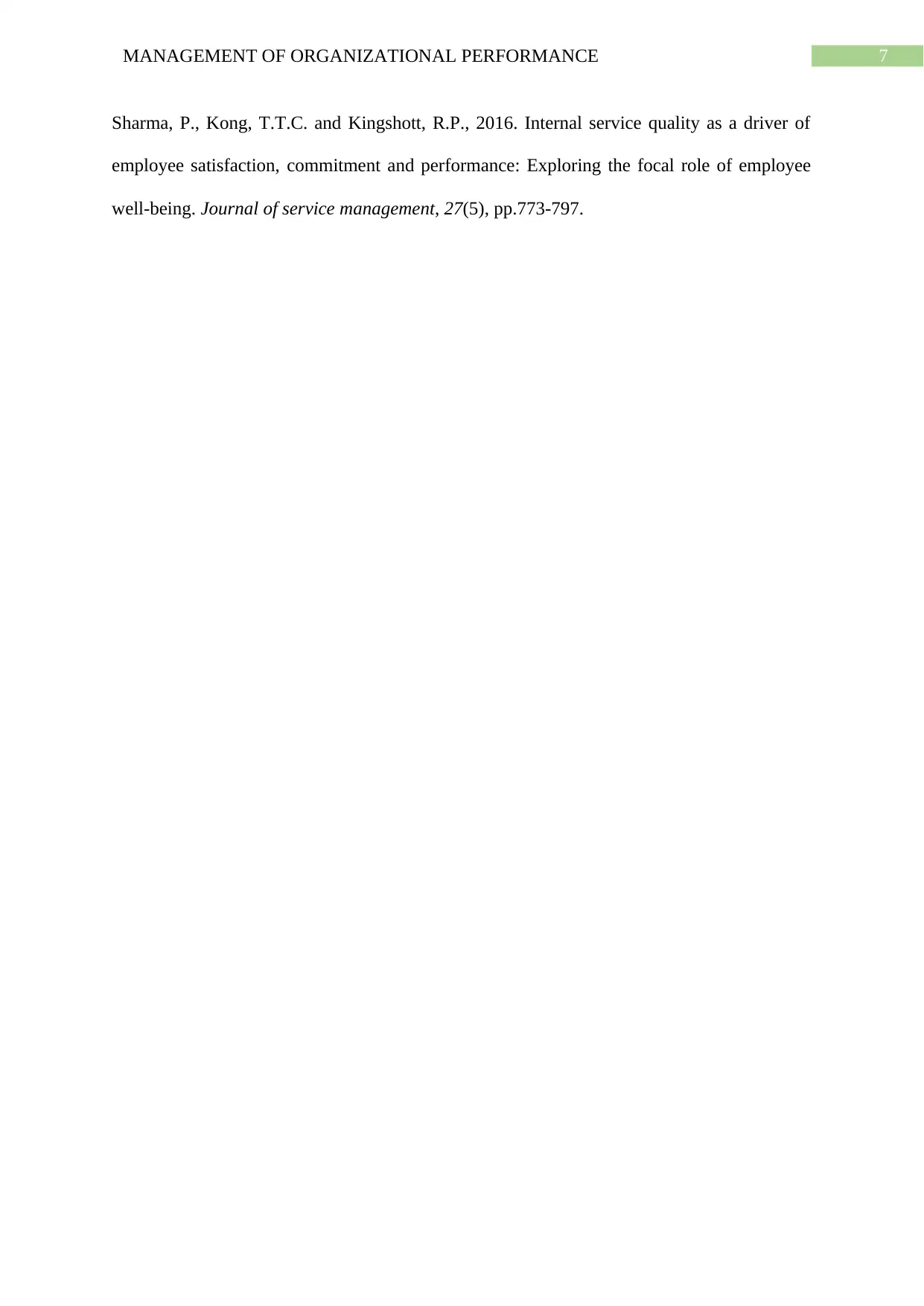
7MANAGEMENT OF ORGANIZATIONAL PERFORMANCE
Sharma, P., Kong, T.T.C. and Kingshott, R.P., 2016. Internal service quality as a driver of
employee satisfaction, commitment and performance: Exploring the focal role of employee
well-being. Journal of service management, 27(5), pp.773-797.
Sharma, P., Kong, T.T.C. and Kingshott, R.P., 2016. Internal service quality as a driver of
employee satisfaction, commitment and performance: Exploring the focal role of employee
well-being. Journal of service management, 27(5), pp.773-797.
1 out of 8
Related Documents
Your All-in-One AI-Powered Toolkit for Academic Success.
+13062052269
info@desklib.com
Available 24*7 on WhatsApp / Email
![[object Object]](/_next/static/media/star-bottom.7253800d.svg)
Unlock your academic potential
© 2024 | Zucol Services PVT LTD | All rights reserved.





